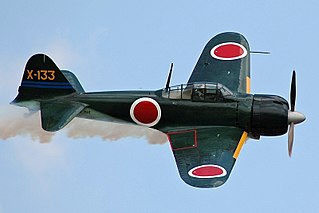
The Mitsubishi A6M "Zero" is a long-range carrier-capable fighter aircraft formerly manufactured by Mitsubishi Aircraft Company, a part of Mitsubishi Heavy Industries. It was operated by the Imperial Japanese Navy (IJN) from 1940 to 1945. The A6M was designated as the Mitsubishi Navy Type 0 carrier fighter, or the Mitsubishi A6M Rei-sen. The A6M was usually referred to by its pilots as the Reisen, "0" being the last digit of the imperial year 2600 (1940) when it entered service with the IJN. The official Allied reporting name was "Zeke", although the name "Zero" was used more commonly.

Williams Air Force Base is a former United States Air Force (USAF) base, located in Maricopa County, Arizona, east of Chandler, and about 30 miles (48 km) southeast of Phoenix. It is a designated Superfund site due to a number of soil and groundwater contaminants.

Saburō Sakai was a Japanese naval aviator and flying ace of the Imperial Japanese Navy during World War II. Sakai had 28 aerial victories, including shared ones, according to official Japanese records, though he and his ghostwriter Martin Caidin claimed much higher numbers.

The Consolidated B-32 Dominator was an American heavy strategic bomber built for the United States Army Air Forces during World War II. A B-32 was involved in the last air combat engagement of the war, resulting the war's last American air combat death. It was developed by Consolidated Aircraft in parallel with the Boeing B-29 Superfortress as a fallback design should the B-29 prove unsuccessful. The B-32 reached units in the Pacific only in mid-May 1945, and subsequently saw only limited combat operations against Japanese targets before the end of the war on 2 September 1945. Most of the extant orders of the B-32 were canceled shortly thereafter and only 118 B-32 airframes of all types were built.

The Museum of Flight is a private non-profit air and space museum in the Seattle metropolitan area. It is located at the southern end of King County International Airport in the city of Tukwila, immediately south of Seattle. It was established in 1965 and is fully accredited by the American Alliance of Museums. As the largest private air and space museum in the world, it also hosts large K–12 educational programs.

The Kawanishi N1K is an Imperial Japanese Navy fighter aircraft, developed in two forms: the N1K Kyōfū, a floatplane designed to support forward offensive operations where no airstrips were available, and the N1K-J Shiden, a land-based version of the N1K. The N1K-J was considered by both its pilots and opponents to be one of the finest land-based fighters flown by the Japanese during World War II.

The Mitsubishi A7MReppū was designed as the successor to the Imperial Japanese Navy's A6M Zero, with development beginning in 1942. Performance objectives were to achieve superior speed, climb, diving, and armament over the Zero, as well as better maneuverability – all parameters that were ultimately achieved towards the end of its development in 1945. However, limitations on Japanese industry towards the end of the war prevented the A7M from ever entering mass production or being deployed for active duty, and it never saw active service. Its Allied reporting name was "Sam".
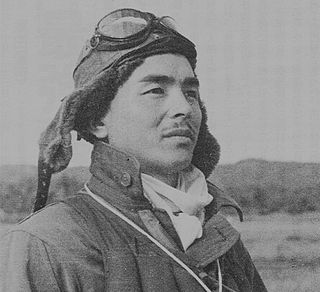
Lieutenant Junior GradeHiroyoshi Nishizawa was a Japanese naval aviator and an ace of the Imperial Japanese Navy Air Service during World War II. Nishizawa was known to his colleagues as 'the Devil' for his breathtaking, brilliant, and unpredictable aerobatics and superb control of his aircraft while in combat. He was a member of the Tainan Kōkūtai's famous "clean up trio" with fellow aces Saburō Sakai and Toshio Ōta and would see action in the New Guinea campaign as well as in the aerial battles over Guadalcanal and over the Solomon Islands. He was killed in 1944 during the Philippines Campaign while aboard an IJN transport aircraft. It is possible that he was the most successful Japanese fighter ace of the war, reportedly telling his last CO that he had achieved a tally of 86 or 87 aerial victories- post war he was linked with scores of 147 or 103, but both of these scores have been considered inaccurate.

Samurai! is a 1957 autobiographical book on Saburo Sakai, ghostwritten by Martin Caidin based on interviews with Fred Saito. It describes the life and career of Sakai, a Japanese combat aviator who fought against American fighter pilots in the Pacific Theater of World War II, surviving the war as one of Japan's leading flying aces. Caidin wrote the prose of the book, basing its contents on Saito's interviews with Sakai as well as on Sakai's own memoirs.
Henry Barrett Tillman is an American author who specializes in naval and aviation topics in addition to fiction and technical writing.
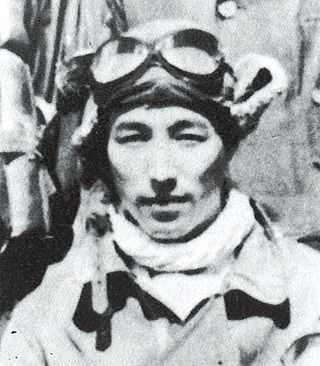
Toshio Ōta was a World War II Japanese fighter ace. In early 1942, at the age of 22, he flew a Mitsubishi A6M Zero with the Lae-based Tainan Air Group. There the young petty officer, 1st class became one of the so-called "Clean-up Trio" of Japanese aces, along with his squadron mates Saburo Sakai and Hiroyoshi Nishizawa.
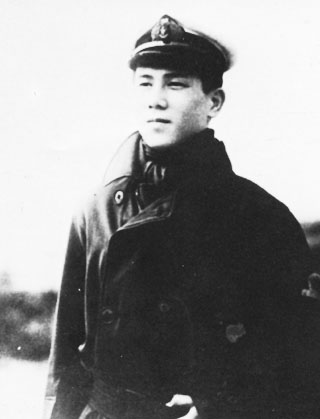
Lieutenant CommanderJunichi Sasai was a Japanese naval aviator and fighter ace of the Imperial Japanese Navy during World War II. Sasai was killed leading his fighter squadron during an attack on Henderson Field during the Battle of Guadalcanal.

James Julien "Pug" Southerland II was a United States Navy fighter pilot during World War II. He was an ace, having been credited with five victories, flying Grumman F4F Wildcats. He was awarded the Silver Star, Distinguished Flying Cross twice, and the Purple Heart.

Kenji Okabe was an ace fighter pilot in the Imperial Japanese Navy (IJN) during World War II. Participating in many of the Pacific War battles and campaigns as a member of several units, Okabe was officially credited with destroying 15 enemy aircraft. Okabe was credited with shooting down eight enemy aircraft on 8 May 1942 during the Battle of the Coral Sea, the IJN's official record for the number of aircraft destroyed in a single encounter. He is famous for his strong opposition to the kamikaze attacks, rare in IJN at the time. Okabe was killed in action in September 1943 over Bougainville, Papua New Guinea.

The Tainan Air Group was a fighter aircraft and airbase garrison unit of the Imperial Japanese Navy (IJN) during the Pacific campaign of World War II. The flying portion of the unit was heavily involved in many of the major campaigns and battles of the first year of the war. The exploits of the unit were widely publicized in the Japanese media at the time, at least in part because the unit spawned more aces than any other fighter unit in the IJN. Several of the unit's aces were among the IJN's top scorers, and included Hiroyoshi Nishizawa, Saburō Sakai, Junichi Sasai, Watari Handa, Masaaki Shimakawa, and Toshio Ōta.
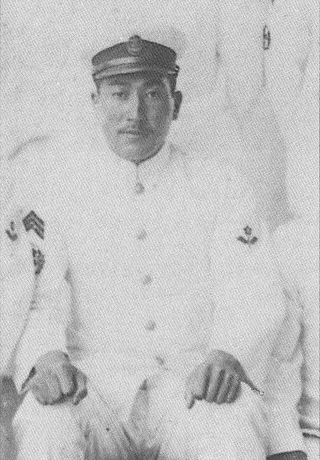
Watari Handa was an officer and ace fighter pilot in the Imperial Japanese Navy (IJN) during the Second Sino-Japanese War and the Pacific theater of World War II. In aerial combat over China and the Pacific, he was officially credited with having destroyed 13 enemy aircraft.

Masaaki Shimakawa was a warrant officer and ace fighter pilot in the Imperial Japanese Navy (IJN) during the Pacific theater of World War II. In aerial combat over the Pacific he was officially credited with destroying eight enemy aircraft with 12 or 13 assists.

Kaneyoshi Muto was a Japanese naval aviator and flying ace known for his great skill in fighter aircraft. Fellow ace Saburō Sakai called him "a genius in the air."

Henry Sakaida was an American writer who authored a number of books relating to World War II. He was a third-generation Japanese-American.

Winged Samurai: Saburo Sakai and the Zero Fighter Pilots is a 1985 book by Henry Sakaida dealing with the wartime history of Saburō Sakai and other Imperial Japanese Navy Air Service pilots who flew the Mitsubishi A6M Zero. It was published by Champlin Fighter Museum Press.



















